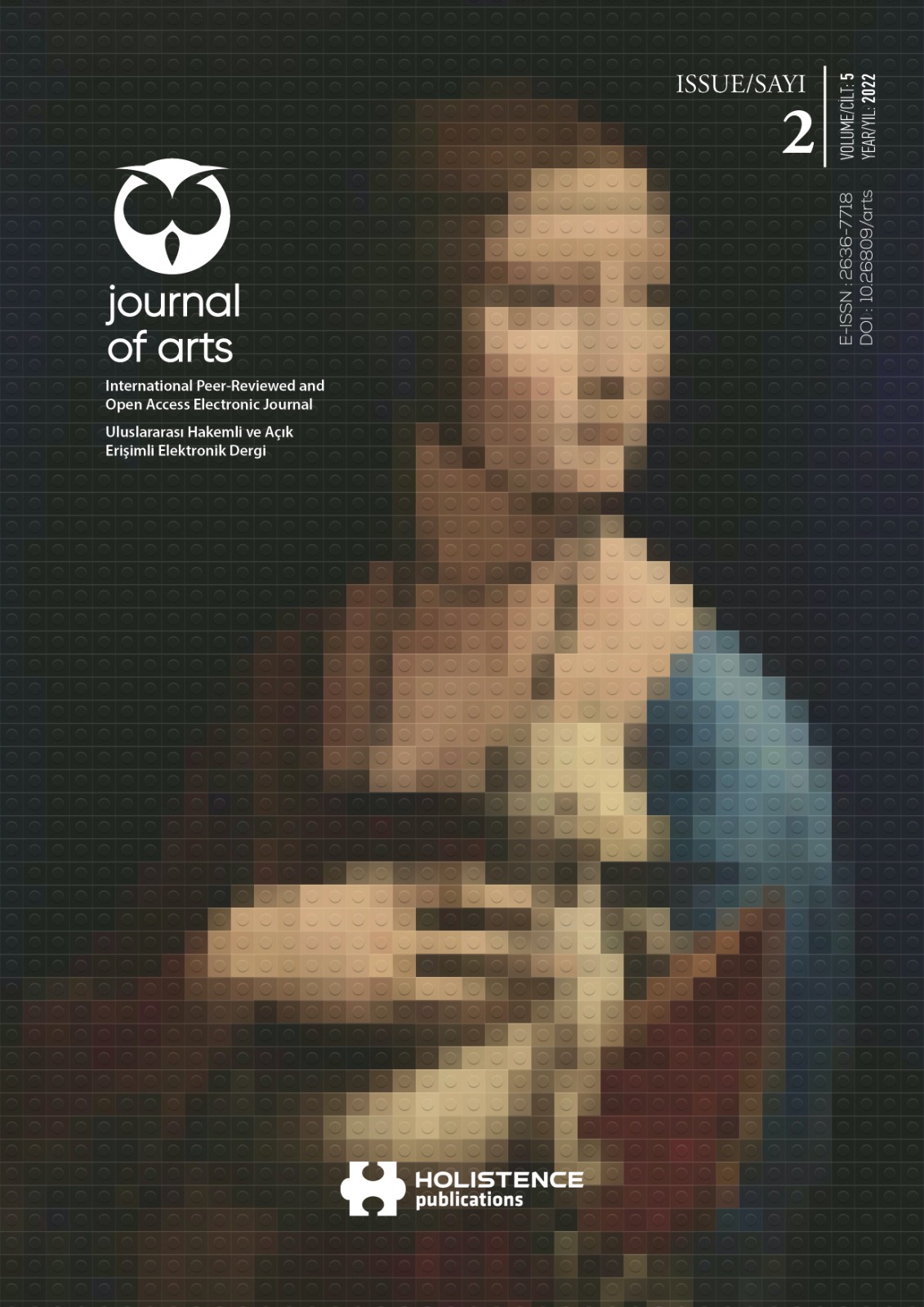A creation experience from theme to choreography: The process of expressing the theme of ‘Being on Journey’ in ‘Selam Olsun’ project through choreography
DOI:
https://doi.org/10.31566/arts.5.2.04Keywords:
theatre, choreography, aarts, mistisizm, Yunus EmreAbstract
Selam Olsun is an theatre project prepared by the academicians and students of the theater department of a state university. The project was created by intertwining storytelling, poetry, dance and music composition in the light of the 13-episode text adapted from S. Eyüboğlu’s book, called Yunus Emre. Selam Olsun’s dramaturgy is based on the theme of being on a spiritual journey, which is the basis of Yunus Emre’s understanding of Sufism. This idea is expressed with a choreography that interacts with other disciplines. The choreography was created by simultaneously reflecting prominent themes of the text on both bodies and space. Improvisation, Skinner Releasing Technique and Laban Movement Analysis methods were used to ensure that the themes are internalized, developed and physically applied by the actors. It has been observed that the theme of being on a spiritual journey, which is an implicit motif in the narrative plane of the text, eventually turned into an active sensory experience within the process of choreography. This article has been written to present a roadmap to those working in this field by examining the elements of choreography in the process of revealing the main theme of the text, together with the relevant literature reviews. As a result of the study, while emphasizing the importance of using choreography in a subtle way in order to transform the theater play into a complete sensory experience, it is suggested that dance, movement and body awareness classes should be handled in a more comprehensive way both in theater plays and in acting education.
Downloads
References
AKSOY ARIKAN, R. (2021). Yunus Emre ve Tasavvuf içinde Ihlamur Anma ve Armağan Kitaplar Dizisi, Yunus Emre. Eds: H. Sarı ve Y. Koşar. s. 208-217, Kayseri: Ihlamur Yayıncılık, 1.Baskı, ISBN: 978-605-749-538-9.
BARNWELL, J. (2011). Film Yapımının Temelleri. Çeviren:. G. Altıntaş. İstanbul: Literatür Kitabevi, 1. Basım, ISBN: 978-975-040-590-7.
BLOM, L.A. & CHAPLIN L.T. (1982). The Intimate Act Of Choreography. Pittsburgh: University of Pittsburgh Press, ISBN: 0-8229-3463-9.
EMSLIE, M.A. (2021). Skinner Releasing Technique, A Movement and Dance Practice. Axminster: Triarchy Press, 1. Basım, ISBN: 978—1-913743-29-1
ERGÜN, S.(2003). Çağdaş Doğaçlama. İstanbul: Mitos Boyut Yayınları, Basım Yılı 2013. ISBN: 978-605-512-734-3
EYÜBOĞLU, S. (2005). Yunus Emre. İstanbul: Türkiye İş Bankası Kültür Yayınları. ISBN: 978-975-458-653-4
NEWLOVE, J. (1993). Laban For Actors and Dancers. London: Nick Hern Books, 4. Basım, ISBN:1-85459-160-6
OIDA, Y. & MARSHALL, L. (1997). Görünmez Oyuncu. Çeviren: Ö. Turhal de Chiara. İstanbul: Boğaziçi Üniversitesi Yayınevi, Basım Yılı 2012, ISBN: 978-605-4787-06-7
ÖNDER, Ö. (2019). Nefesten Solunuma. İstanbul: Kuraldışı Yayıncılık, 1. Baskı, ISBN: 978-975-275-425-6
PENGUIN RANDOM HOUSE. (2021). Semboller ve İşaretler. Çeviren: S. Toksoy. İstanbul: Alfa Yayınları, 5. Basım, ISBN: 978-605-106-143-6
SMITH-AUTARD, J. M.(1976). Dance Composition. Londra: A&C Black Publishers, 3. Baskı, ISBN: 0-7136-4510-5
TAVUKÇU, O.K. (Ed.). (2017). Yunus Emre Kitabı. Aksaray: Akçağ Yayınevi, 1. Baskı, ISBN: 978-605-149-932-1
AYAZ, N. & SULTANOVA, A. (2013). Mevlevilik ve Bektaşılığın Simgesi olan Ayin ve Ayin Müziğinin Karşılıklı Tahlili. İdil Dergisi. 2(13), 119-134.
GÜRAY, C. (2010). Sema’dan Semah’a Bir Sonsuz Devir. Türk Kültürü ve Hacı Bektaş Veli Araştırma Dergisi. 2010(56). 119-152
ÖZGEN, M. K. (2013). Tasavvuf Felsefesinde Zikir Kavramı. Muş Alparslan Üniversitesi Sosyal Bilimler Dergisi. 1(2), 215-227.
TAMAY, S. (2009). Bir İbadet Ritüeli Olarak Semah ve Tahtacı Turnalar Semahının Halk Bilimi ve Müzik Bilimi Açısından İncelenmesi. Alevilik Bektaşilik Araştırmaları Dergisi. 1(1), 163-185.
KÜÇÜK, H. (2009). Semazen [online]. Türk İslam Ansiklopedisi. 36. Cilt. İstanbul,
https://cdn2.islamansiklopedisi.org.tr/dosya/36/C36012004.pdf [Erişim Tarihi: 16.04.2022].
T.C. Kültür ve Turizm Bakanlığı Araştırma ve Eğitim Genel Müdürlüğü. (2008). Mevlevi Sema Töreni [online]. Ankara, https://aregem.ktb.gov.tr/TR-202225/mevlevi-sema-toreni.html. [Erişim Tarihi: 16.04.2022].
Additional Files
Published
How to Cite
Issue
Section
License
Copyright (c) 2022 Holistence Publications

This work is licensed under a Creative Commons Attribution 4.0 International License.
When the article is accepted for publication in the Journal of Arts, authors transfer all copyright in the article to the Rating Academy Ar-Ge Yazılım Yayıncılık Eğitim Danışmanlık ve Organizasyon Ticaret Ltd. Şti.The authors reserve all proprietary right other than copyright, such as patent rights.
Everyone who is listed as an author in this article should have made a substantial, direct, intellectual contribution to the work and should take public responsibility for it.
This paper contains works that have not previously published or not under consideration for publication in other journals.










